Media Annotation: CPR Simulation Video Analysis and Appraisal
VerifiedAdded on 2022/11/14
|12
|3332
|312
Report
AI Summary
This report provides a comprehensive analysis of a CPR simulation video, specifically the 'Christiana Care Health System’s Code Blue Simulation Program.' The analysis critically evaluates the video's adherence to the Australian Resuscitation Council (ARC) and ANZCOR guidelines for cardiopulmonary resuscitation (CPR). The report dissects the technical and non-technical aspects of the simulation, highlighting strengths such as the nurse's leadership skills and clear communication, while also pinpointing weaknesses like deviations from the DRS ABCD assessment and incorrect defibrillator settings. The student provides recommendations for practice changes, emphasizing the importance of following established guidelines and implementing best practices to improve the effectiveness of CPR in emergency scenarios. The report supports its claims with citations from peer-reviewed journals and the ARC and ANZCOR guidelines, offering a detailed assessment of the simulation's quality and practical implications for healthcare professionals.
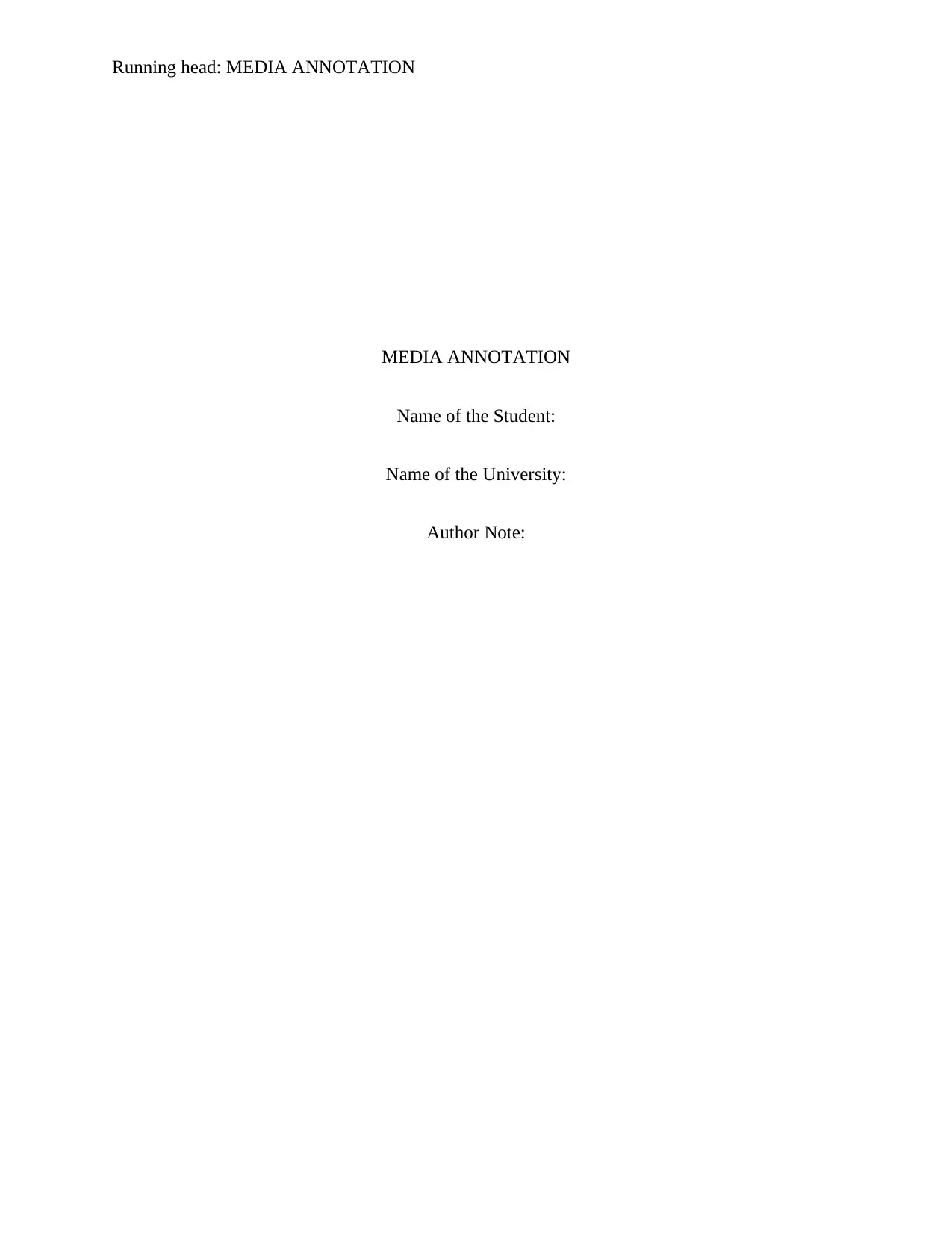
Running head: MEDIA ANNOTATION
MEDIA ANNOTATION
Name of the Student:
Name of the University:
Author Note:
MEDIA ANNOTATION
Name of the Student:
Name of the University:
Author Note:
Paraphrase This Document
Need a fresh take? Get an instant paraphrase of this document with our AI Paraphraser
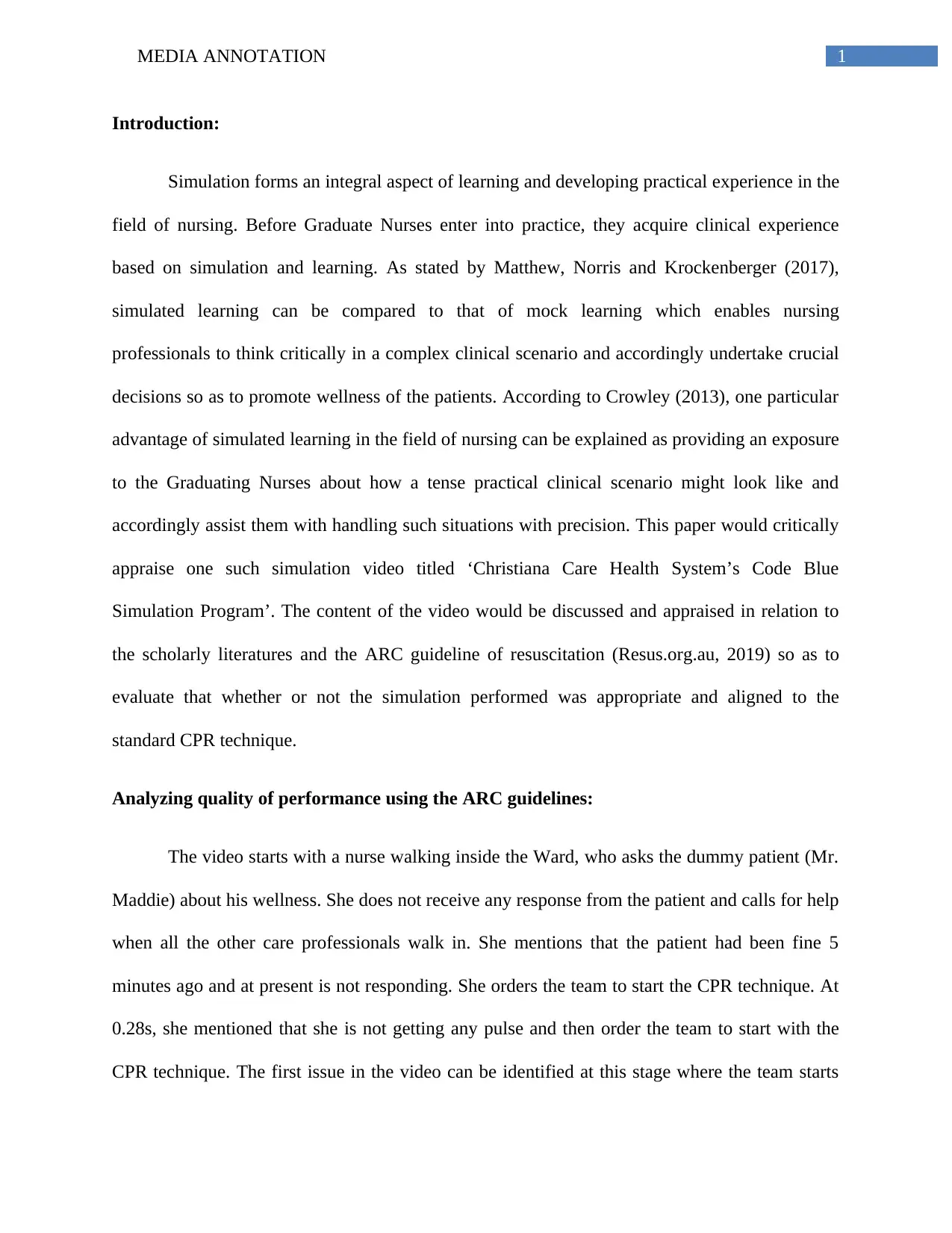
1MEDIA ANNOTATION
Introduction:
Simulation forms an integral aspect of learning and developing practical experience in the
field of nursing. Before Graduate Nurses enter into practice, they acquire clinical experience
based on simulation and learning. As stated by Matthew, Norris and Krockenberger (2017),
simulated learning can be compared to that of mock learning which enables nursing
professionals to think critically in a complex clinical scenario and accordingly undertake crucial
decisions so as to promote wellness of the patients. According to Crowley (2013), one particular
advantage of simulated learning in the field of nursing can be explained as providing an exposure
to the Graduating Nurses about how a tense practical clinical scenario might look like and
accordingly assist them with handling such situations with precision. This paper would critically
appraise one such simulation video titled ‘Christiana Care Health System’s Code Blue
Simulation Program’. The content of the video would be discussed and appraised in relation to
the scholarly literatures and the ARC guideline of resuscitation (Resus.org.au, 2019) so as to
evaluate that whether or not the simulation performed was appropriate and aligned to the
standard CPR technique.
Analyzing quality of performance using the ARC guidelines:
The video starts with a nurse walking inside the Ward, who asks the dummy patient (Mr.
Maddie) about his wellness. She does not receive any response from the patient and calls for help
when all the other care professionals walk in. She mentions that the patient had been fine 5
minutes ago and at present is not responding. She orders the team to start the CPR technique. At
0.28s, she mentioned that she is not getting any pulse and then order the team to start with the
CPR technique. The first issue in the video can be identified at this stage where the team starts
Introduction:
Simulation forms an integral aspect of learning and developing practical experience in the
field of nursing. Before Graduate Nurses enter into practice, they acquire clinical experience
based on simulation and learning. As stated by Matthew, Norris and Krockenberger (2017),
simulated learning can be compared to that of mock learning which enables nursing
professionals to think critically in a complex clinical scenario and accordingly undertake crucial
decisions so as to promote wellness of the patients. According to Crowley (2013), one particular
advantage of simulated learning in the field of nursing can be explained as providing an exposure
to the Graduating Nurses about how a tense practical clinical scenario might look like and
accordingly assist them with handling such situations with precision. This paper would critically
appraise one such simulation video titled ‘Christiana Care Health System’s Code Blue
Simulation Program’. The content of the video would be discussed and appraised in relation to
the scholarly literatures and the ARC guideline of resuscitation (Resus.org.au, 2019) so as to
evaluate that whether or not the simulation performed was appropriate and aligned to the
standard CPR technique.
Analyzing quality of performance using the ARC guidelines:
The video starts with a nurse walking inside the Ward, who asks the dummy patient (Mr.
Maddie) about his wellness. She does not receive any response from the patient and calls for help
when all the other care professionals walk in. She mentions that the patient had been fine 5
minutes ago and at present is not responding. She orders the team to start the CPR technique. At
0.28s, she mentioned that she is not getting any pulse and then order the team to start with the
CPR technique. The first issue in the video can be identified at this stage where the team starts
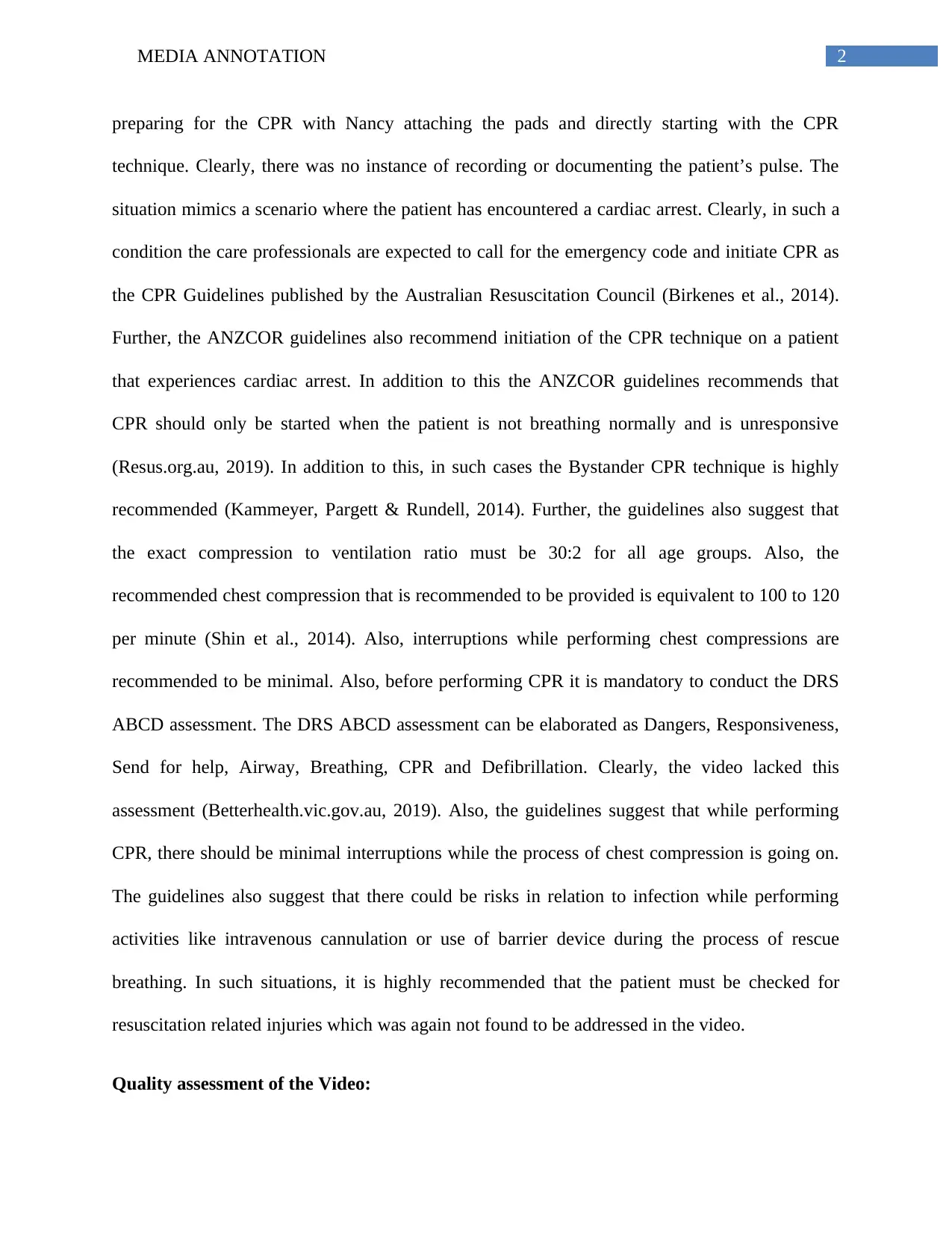
2MEDIA ANNOTATION
preparing for the CPR with Nancy attaching the pads and directly starting with the CPR
technique. Clearly, there was no instance of recording or documenting the patient’s pulse. The
situation mimics a scenario where the patient has encountered a cardiac arrest. Clearly, in such a
condition the care professionals are expected to call for the emergency code and initiate CPR as
the CPR Guidelines published by the Australian Resuscitation Council (Birkenes et al., 2014).
Further, the ANZCOR guidelines also recommend initiation of the CPR technique on a patient
that experiences cardiac arrest. In addition to this the ANZCOR guidelines recommends that
CPR should only be started when the patient is not breathing normally and is unresponsive
(Resus.org.au, 2019). In addition to this, in such cases the Bystander CPR technique is highly
recommended (Kammeyer, Pargett & Rundell, 2014). Further, the guidelines also suggest that
the exact compression to ventilation ratio must be 30:2 for all age groups. Also, the
recommended chest compression that is recommended to be provided is equivalent to 100 to 120
per minute (Shin et al., 2014). Also, interruptions while performing chest compressions are
recommended to be minimal. Also, before performing CPR it is mandatory to conduct the DRS
ABCD assessment. The DRS ABCD assessment can be elaborated as Dangers, Responsiveness,
Send for help, Airway, Breathing, CPR and Defibrillation. Clearly, the video lacked this
assessment (Betterhealth.vic.gov.au, 2019). Also, the guidelines suggest that while performing
CPR, there should be minimal interruptions while the process of chest compression is going on.
The guidelines also suggest that there could be risks in relation to infection while performing
activities like intravenous cannulation or use of barrier device during the process of rescue
breathing. In such situations, it is highly recommended that the patient must be checked for
resuscitation related injuries which was again not found to be addressed in the video.
Quality assessment of the Video:
preparing for the CPR with Nancy attaching the pads and directly starting with the CPR
technique. Clearly, there was no instance of recording or documenting the patient’s pulse. The
situation mimics a scenario where the patient has encountered a cardiac arrest. Clearly, in such a
condition the care professionals are expected to call for the emergency code and initiate CPR as
the CPR Guidelines published by the Australian Resuscitation Council (Birkenes et al., 2014).
Further, the ANZCOR guidelines also recommend initiation of the CPR technique on a patient
that experiences cardiac arrest. In addition to this the ANZCOR guidelines recommends that
CPR should only be started when the patient is not breathing normally and is unresponsive
(Resus.org.au, 2019). In addition to this, in such cases the Bystander CPR technique is highly
recommended (Kammeyer, Pargett & Rundell, 2014). Further, the guidelines also suggest that
the exact compression to ventilation ratio must be 30:2 for all age groups. Also, the
recommended chest compression that is recommended to be provided is equivalent to 100 to 120
per minute (Shin et al., 2014). Also, interruptions while performing chest compressions are
recommended to be minimal. Also, before performing CPR it is mandatory to conduct the DRS
ABCD assessment. The DRS ABCD assessment can be elaborated as Dangers, Responsiveness,
Send for help, Airway, Breathing, CPR and Defibrillation. Clearly, the video lacked this
assessment (Betterhealth.vic.gov.au, 2019). Also, the guidelines suggest that while performing
CPR, there should be minimal interruptions while the process of chest compression is going on.
The guidelines also suggest that there could be risks in relation to infection while performing
activities like intravenous cannulation or use of barrier device during the process of rescue
breathing. In such situations, it is highly recommended that the patient must be checked for
resuscitation related injuries which was again not found to be addressed in the video.
Quality assessment of the Video:
⊘ This is a preview!⊘
Do you want full access?
Subscribe today to unlock all pages.

Trusted by 1+ million students worldwide
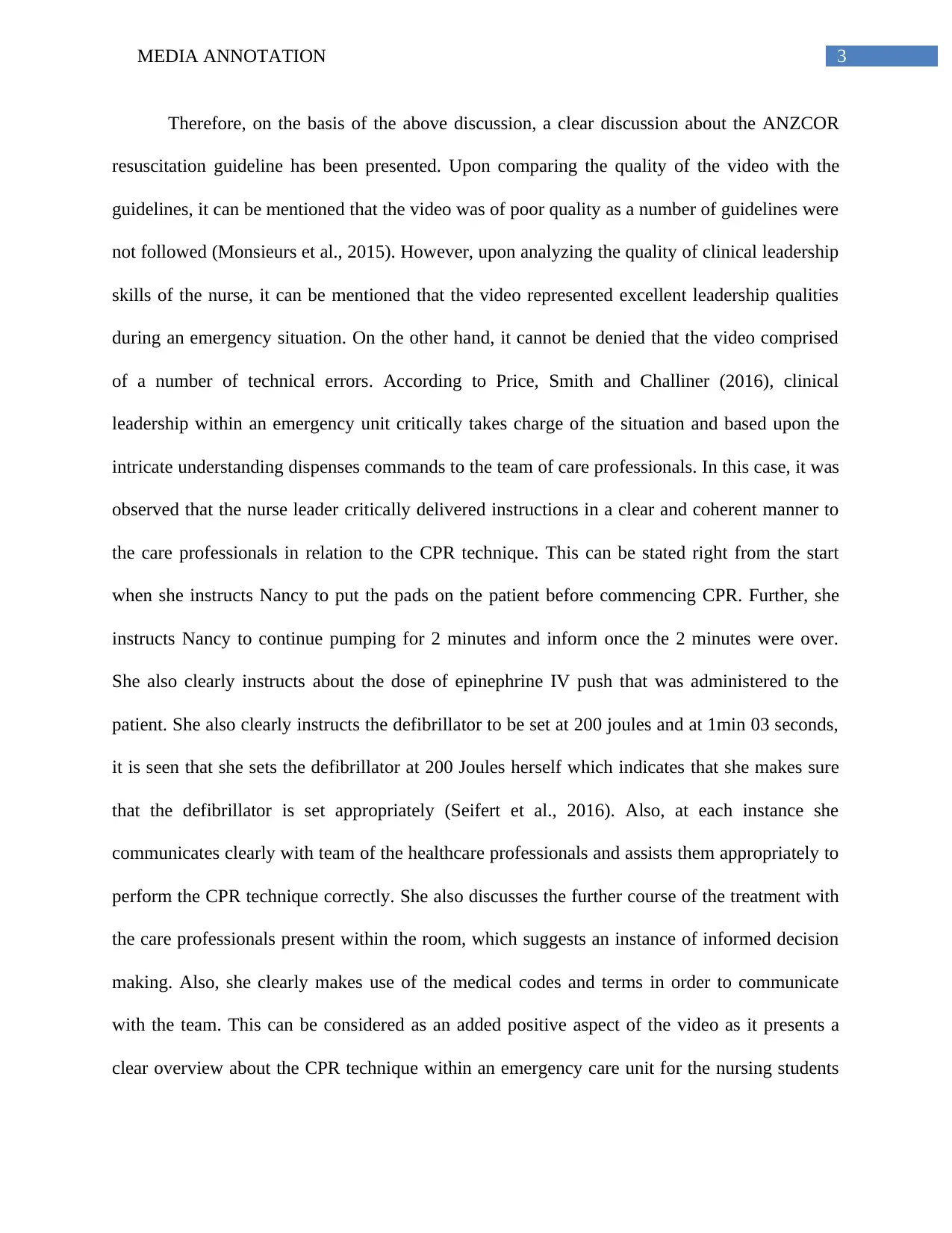
3MEDIA ANNOTATION
Therefore, on the basis of the above discussion, a clear discussion about the ANZCOR
resuscitation guideline has been presented. Upon comparing the quality of the video with the
guidelines, it can be mentioned that the video was of poor quality as a number of guidelines were
not followed (Monsieurs et al., 2015). However, upon analyzing the quality of clinical leadership
skills of the nurse, it can be mentioned that the video represented excellent leadership qualities
during an emergency situation. On the other hand, it cannot be denied that the video comprised
of a number of technical errors. According to Price, Smith and Challiner (2016), clinical
leadership within an emergency unit critically takes charge of the situation and based upon the
intricate understanding dispenses commands to the team of care professionals. In this case, it was
observed that the nurse leader critically delivered instructions in a clear and coherent manner to
the care professionals in relation to the CPR technique. This can be stated right from the start
when she instructs Nancy to put the pads on the patient before commencing CPR. Further, she
instructs Nancy to continue pumping for 2 minutes and inform once the 2 minutes were over.
She also clearly instructs about the dose of epinephrine IV push that was administered to the
patient. She also clearly instructs the defibrillator to be set at 200 joules and at 1min 03 seconds,
it is seen that she sets the defibrillator at 200 Joules herself which indicates that she makes sure
that the defibrillator is set appropriately (Seifert et al., 2016). Also, at each instance she
communicates clearly with team of the healthcare professionals and assists them appropriately to
perform the CPR technique correctly. She also discusses the further course of the treatment with
the care professionals present within the room, which suggests an instance of informed decision
making. Also, she clearly makes use of the medical codes and terms in order to communicate
with the team. This can be considered as an added positive aspect of the video as it presents a
clear overview about the CPR technique within an emergency care unit for the nursing students
Therefore, on the basis of the above discussion, a clear discussion about the ANZCOR
resuscitation guideline has been presented. Upon comparing the quality of the video with the
guidelines, it can be mentioned that the video was of poor quality as a number of guidelines were
not followed (Monsieurs et al., 2015). However, upon analyzing the quality of clinical leadership
skills of the nurse, it can be mentioned that the video represented excellent leadership qualities
during an emergency situation. On the other hand, it cannot be denied that the video comprised
of a number of technical errors. According to Price, Smith and Challiner (2016), clinical
leadership within an emergency unit critically takes charge of the situation and based upon the
intricate understanding dispenses commands to the team of care professionals. In this case, it was
observed that the nurse leader critically delivered instructions in a clear and coherent manner to
the care professionals in relation to the CPR technique. This can be stated right from the start
when she instructs Nancy to put the pads on the patient before commencing CPR. Further, she
instructs Nancy to continue pumping for 2 minutes and inform once the 2 minutes were over.
She also clearly instructs about the dose of epinephrine IV push that was administered to the
patient. She also clearly instructs the defibrillator to be set at 200 joules and at 1min 03 seconds,
it is seen that she sets the defibrillator at 200 Joules herself which indicates that she makes sure
that the defibrillator is set appropriately (Seifert et al., 2016). Also, at each instance she
communicates clearly with team of the healthcare professionals and assists them appropriately to
perform the CPR technique correctly. She also discusses the further course of the treatment with
the care professionals present within the room, which suggests an instance of informed decision
making. Also, she clearly makes use of the medical codes and terms in order to communicate
with the team. This can be considered as an added positive aspect of the video as it presents a
clear overview about the CPR technique within an emergency care unit for the nursing students
Paraphrase This Document
Need a fresh take? Get an instant paraphrase of this document with our AI Paraphraser
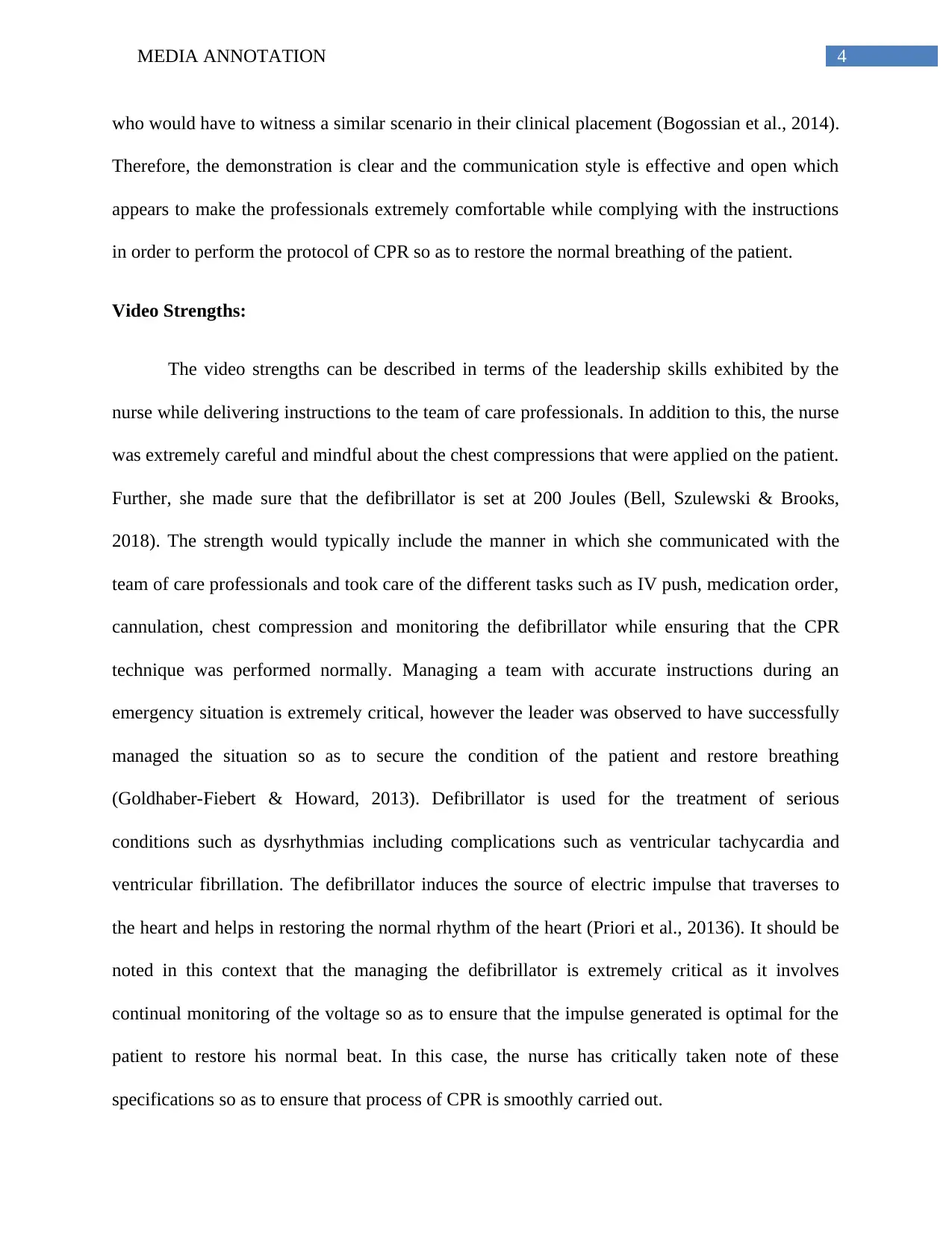
4MEDIA ANNOTATION
who would have to witness a similar scenario in their clinical placement (Bogossian et al., 2014).
Therefore, the demonstration is clear and the communication style is effective and open which
appears to make the professionals extremely comfortable while complying with the instructions
in order to perform the protocol of CPR so as to restore the normal breathing of the patient.
Video Strengths:
The video strengths can be described in terms of the leadership skills exhibited by the
nurse while delivering instructions to the team of care professionals. In addition to this, the nurse
was extremely careful and mindful about the chest compressions that were applied on the patient.
Further, she made sure that the defibrillator is set at 200 Joules (Bell, Szulewski & Brooks,
2018). The strength would typically include the manner in which she communicated with the
team of care professionals and took care of the different tasks such as IV push, medication order,
cannulation, chest compression and monitoring the defibrillator while ensuring that the CPR
technique was performed normally. Managing a team with accurate instructions during an
emergency situation is extremely critical, however the leader was observed to have successfully
managed the situation so as to secure the condition of the patient and restore breathing
(Goldhaber-Fiebert & Howard, 2013). Defibrillator is used for the treatment of serious
conditions such as dysrhythmias including complications such as ventricular tachycardia and
ventricular fibrillation. The defibrillator induces the source of electric impulse that traverses to
the heart and helps in restoring the normal rhythm of the heart (Priori et al., 20136). It should be
noted in this context that the managing the defibrillator is extremely critical as it involves
continual monitoring of the voltage so as to ensure that the impulse generated is optimal for the
patient to restore his normal beat. In this case, the nurse has critically taken note of these
specifications so as to ensure that process of CPR is smoothly carried out.
who would have to witness a similar scenario in their clinical placement (Bogossian et al., 2014).
Therefore, the demonstration is clear and the communication style is effective and open which
appears to make the professionals extremely comfortable while complying with the instructions
in order to perform the protocol of CPR so as to restore the normal breathing of the patient.
Video Strengths:
The video strengths can be described in terms of the leadership skills exhibited by the
nurse while delivering instructions to the team of care professionals. In addition to this, the nurse
was extremely careful and mindful about the chest compressions that were applied on the patient.
Further, she made sure that the defibrillator is set at 200 Joules (Bell, Szulewski & Brooks,
2018). The strength would typically include the manner in which she communicated with the
team of care professionals and took care of the different tasks such as IV push, medication order,
cannulation, chest compression and monitoring the defibrillator while ensuring that the CPR
technique was performed normally. Managing a team with accurate instructions during an
emergency situation is extremely critical, however the leader was observed to have successfully
managed the situation so as to secure the condition of the patient and restore breathing
(Goldhaber-Fiebert & Howard, 2013). Defibrillator is used for the treatment of serious
conditions such as dysrhythmias including complications such as ventricular tachycardia and
ventricular fibrillation. The defibrillator induces the source of electric impulse that traverses to
the heart and helps in restoring the normal rhythm of the heart (Priori et al., 20136). It should be
noted in this context that the managing the defibrillator is extremely critical as it involves
continual monitoring of the voltage so as to ensure that the impulse generated is optimal for the
patient to restore his normal beat. In this case, the nurse has critically taken note of these
specifications so as to ensure that process of CPR is smoothly carried out.

5MEDIA ANNOTATION
Video weaknesses:
On the other hand, if the technical aspect of the video and the ANZCOR guidelines are
correlated a number of flaws or weaknesses can be detected. The first and the foremost being, as
soon as the leader enters the room, she calls for the care professionals and instructs them to start
with the CPR procedure. Clearly, the procedure was not preceded by a set of vital assessment or
pulse rate reading (Leman & Morley, 2016). This can be considered extremely ambiguous and
this clearly violated the ANZCOR guidelines of cardiopulmonary resuscitation procedure. The
multidisplinary team of professionals does not access the heart beat or the pulse rate but directly
start with the CPR procedure. In this context, it can be said that the clear protocol of the CPR
technique had not been followed (Neumar et al., 2015). Further, the DRS ABCD which has been
stated as the initial procedure of the CPR technique has not been followed in the video. The team
of nurses did not check for danger or hazards or responses. Also, there is no mention about the
pateint’s code status. In addition to this, the airway or the breathing was not accessed for any
obstruction or abnormal rhythmic breathing. The CPR protocol as per the ANZCOR guideline
mentions that the chest compression must be maintained at 30 at the interval of two breaths.
Also, the video did not show the administration of IV fluid to the patient which suggests again is
an important aspect of the CPR protocol. Another weakness of the video can be identified at the
instances where the leader, instructed the defibrillator to be set at 200 Joules. As per Campbell
(2014), during the CPR technique, the defibrillator should be set in between 100J to 120 J and
accordingly based on the patient’s response, the stimulation should be increased with the
maximum being 200 J. However, in the video, it was seen that from the initial start, the nurse
leader instructed the defibrillator to be set at 200 J. Another, weakness or problem that was
identified in the video was the electric impulse that was dispensed from the defibrillator. While
Video weaknesses:
On the other hand, if the technical aspect of the video and the ANZCOR guidelines are
correlated a number of flaws or weaknesses can be detected. The first and the foremost being, as
soon as the leader enters the room, she calls for the care professionals and instructs them to start
with the CPR procedure. Clearly, the procedure was not preceded by a set of vital assessment or
pulse rate reading (Leman & Morley, 2016). This can be considered extremely ambiguous and
this clearly violated the ANZCOR guidelines of cardiopulmonary resuscitation procedure. The
multidisplinary team of professionals does not access the heart beat or the pulse rate but directly
start with the CPR procedure. In this context, it can be said that the clear protocol of the CPR
technique had not been followed (Neumar et al., 2015). Further, the DRS ABCD which has been
stated as the initial procedure of the CPR technique has not been followed in the video. The team
of nurses did not check for danger or hazards or responses. Also, there is no mention about the
pateint’s code status. In addition to this, the airway or the breathing was not accessed for any
obstruction or abnormal rhythmic breathing. The CPR protocol as per the ANZCOR guideline
mentions that the chest compression must be maintained at 30 at the interval of two breaths.
Also, the video did not show the administration of IV fluid to the patient which suggests again is
an important aspect of the CPR protocol. Another weakness of the video can be identified at the
instances where the leader, instructed the defibrillator to be set at 200 Joules. As per Campbell
(2014), during the CPR technique, the defibrillator should be set in between 100J to 120 J and
accordingly based on the patient’s response, the stimulation should be increased with the
maximum being 200 J. However, in the video, it was seen that from the initial start, the nurse
leader instructed the defibrillator to be set at 200 J. Another, weakness or problem that was
identified in the video was the electric impulse that was dispensed from the defibrillator. While
⊘ This is a preview!⊘
Do you want full access?
Subscribe today to unlock all pages.

Trusted by 1+ million students worldwide
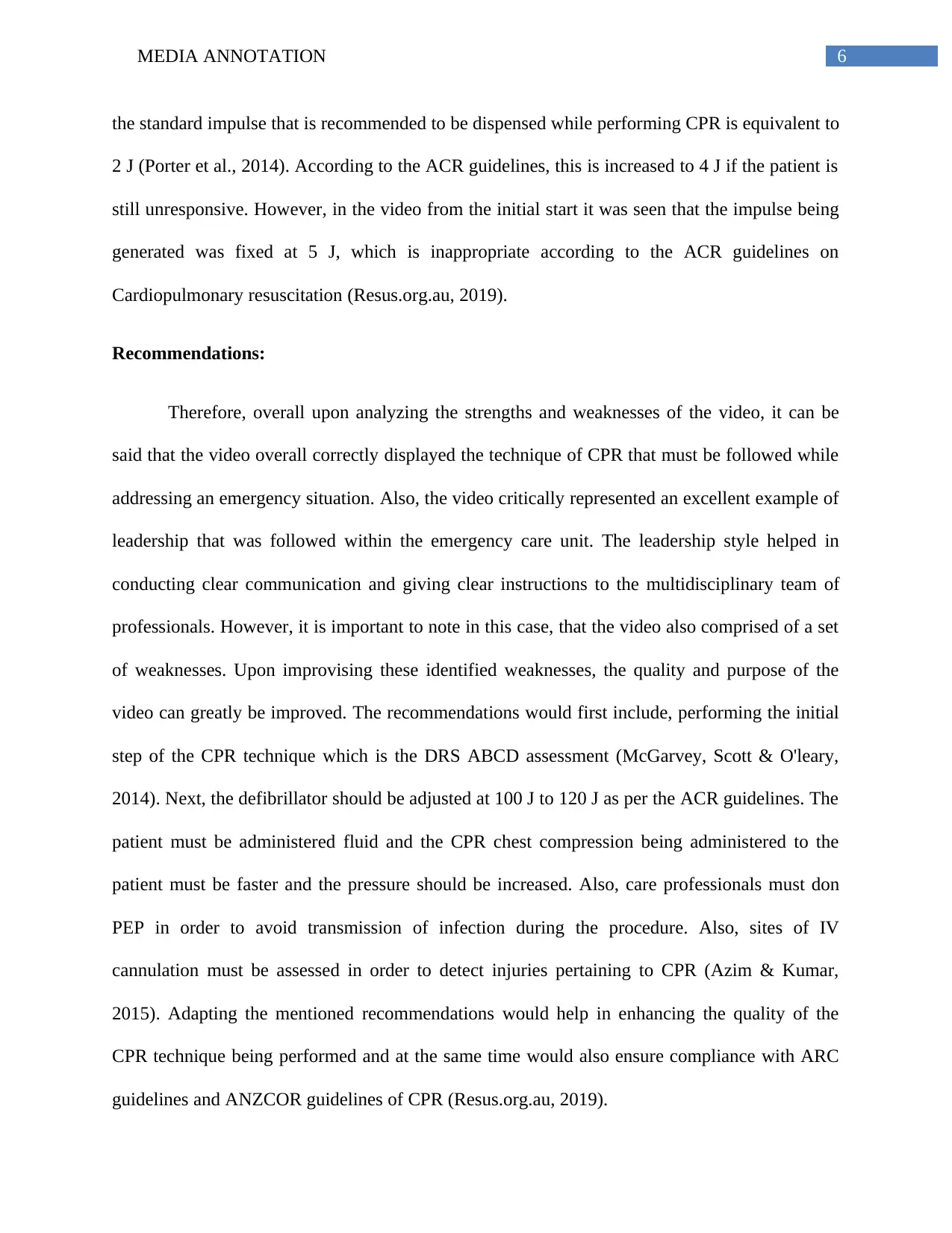
6MEDIA ANNOTATION
the standard impulse that is recommended to be dispensed while performing CPR is equivalent to
2 J (Porter et al., 2014). According to the ACR guidelines, this is increased to 4 J if the patient is
still unresponsive. However, in the video from the initial start it was seen that the impulse being
generated was fixed at 5 J, which is inappropriate according to the ACR guidelines on
Cardiopulmonary resuscitation (Resus.org.au, 2019).
Recommendations:
Therefore, overall upon analyzing the strengths and weaknesses of the video, it can be
said that the video overall correctly displayed the technique of CPR that must be followed while
addressing an emergency situation. Also, the video critically represented an excellent example of
leadership that was followed within the emergency care unit. The leadership style helped in
conducting clear communication and giving clear instructions to the multidisciplinary team of
professionals. However, it is important to note in this case, that the video also comprised of a set
of weaknesses. Upon improvising these identified weaknesses, the quality and purpose of the
video can greatly be improved. The recommendations would first include, performing the initial
step of the CPR technique which is the DRS ABCD assessment (McGarvey, Scott & O'leary,
2014). Next, the defibrillator should be adjusted at 100 J to 120 J as per the ACR guidelines. The
patient must be administered fluid and the CPR chest compression being administered to the
patient must be faster and the pressure should be increased. Also, care professionals must don
PEP in order to avoid transmission of infection during the procedure. Also, sites of IV
cannulation must be assessed in order to detect injuries pertaining to CPR (Azim & Kumar,
2015). Adapting the mentioned recommendations would help in enhancing the quality of the
CPR technique being performed and at the same time would also ensure compliance with ARC
guidelines and ANZCOR guidelines of CPR (Resus.org.au, 2019).
the standard impulse that is recommended to be dispensed while performing CPR is equivalent to
2 J (Porter et al., 2014). According to the ACR guidelines, this is increased to 4 J if the patient is
still unresponsive. However, in the video from the initial start it was seen that the impulse being
generated was fixed at 5 J, which is inappropriate according to the ACR guidelines on
Cardiopulmonary resuscitation (Resus.org.au, 2019).
Recommendations:
Therefore, overall upon analyzing the strengths and weaknesses of the video, it can be
said that the video overall correctly displayed the technique of CPR that must be followed while
addressing an emergency situation. Also, the video critically represented an excellent example of
leadership that was followed within the emergency care unit. The leadership style helped in
conducting clear communication and giving clear instructions to the multidisciplinary team of
professionals. However, it is important to note in this case, that the video also comprised of a set
of weaknesses. Upon improvising these identified weaknesses, the quality and purpose of the
video can greatly be improved. The recommendations would first include, performing the initial
step of the CPR technique which is the DRS ABCD assessment (McGarvey, Scott & O'leary,
2014). Next, the defibrillator should be adjusted at 100 J to 120 J as per the ACR guidelines. The
patient must be administered fluid and the CPR chest compression being administered to the
patient must be faster and the pressure should be increased. Also, care professionals must don
PEP in order to avoid transmission of infection during the procedure. Also, sites of IV
cannulation must be assessed in order to detect injuries pertaining to CPR (Azim & Kumar,
2015). Adapting the mentioned recommendations would help in enhancing the quality of the
CPR technique being performed and at the same time would also ensure compliance with ARC
guidelines and ANZCOR guidelines of CPR (Resus.org.au, 2019).
Paraphrase This Document
Need a fresh take? Get an instant paraphrase of this document with our AI Paraphraser
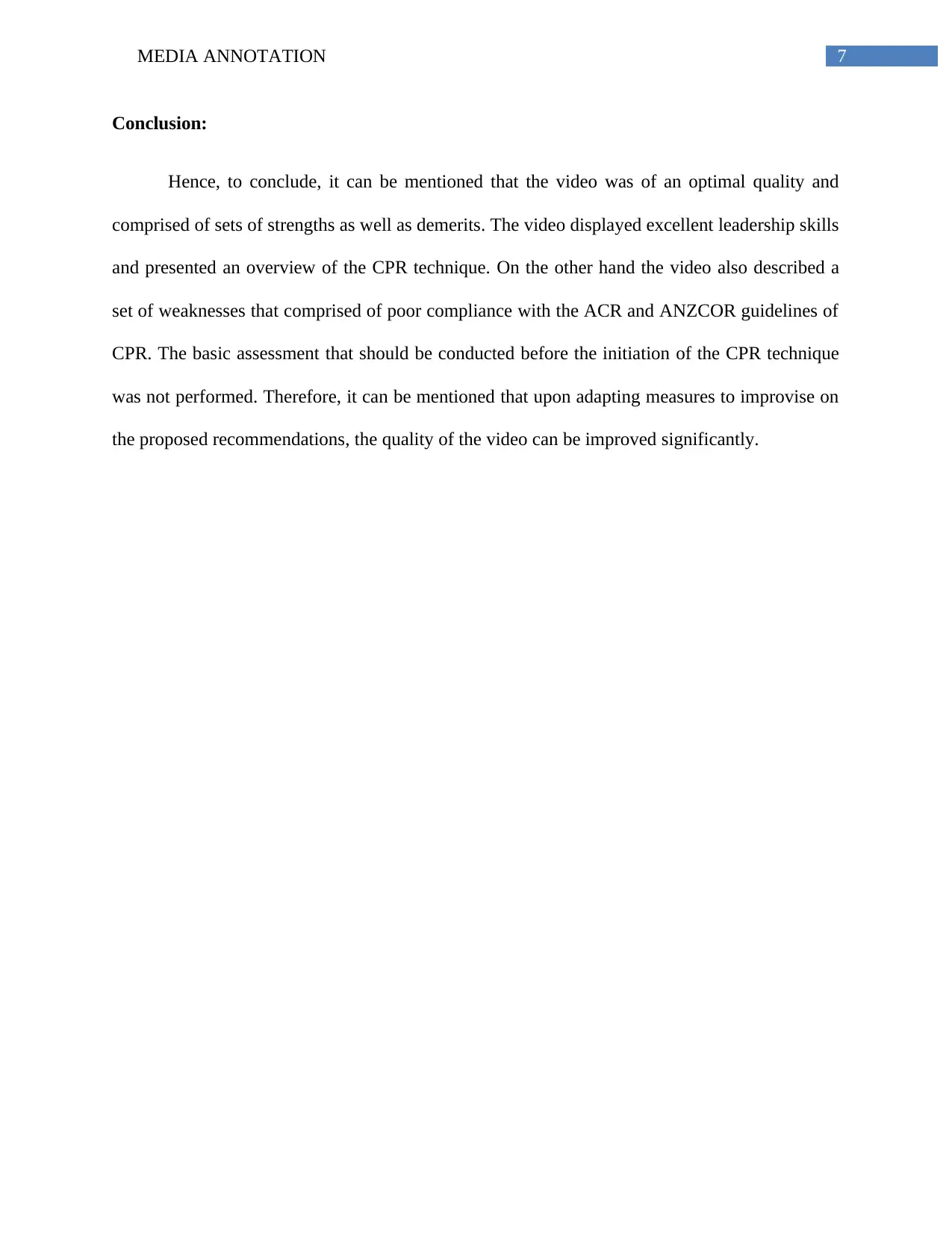
7MEDIA ANNOTATION
Conclusion:
Hence, to conclude, it can be mentioned that the video was of an optimal quality and
comprised of sets of strengths as well as demerits. The video displayed excellent leadership skills
and presented an overview of the CPR technique. On the other hand the video also described a
set of weaknesses that comprised of poor compliance with the ACR and ANZCOR guidelines of
CPR. The basic assessment that should be conducted before the initiation of the CPR technique
was not performed. Therefore, it can be mentioned that upon adapting measures to improvise on
the proposed recommendations, the quality of the video can be improved significantly.
Conclusion:
Hence, to conclude, it can be mentioned that the video was of an optimal quality and
comprised of sets of strengths as well as demerits. The video displayed excellent leadership skills
and presented an overview of the CPR technique. On the other hand the video also described a
set of weaknesses that comprised of poor compliance with the ACR and ANZCOR guidelines of
CPR. The basic assessment that should be conducted before the initiation of the CPR technique
was not performed. Therefore, it can be mentioned that upon adapting measures to improvise on
the proposed recommendations, the quality of the video can be improved significantly.
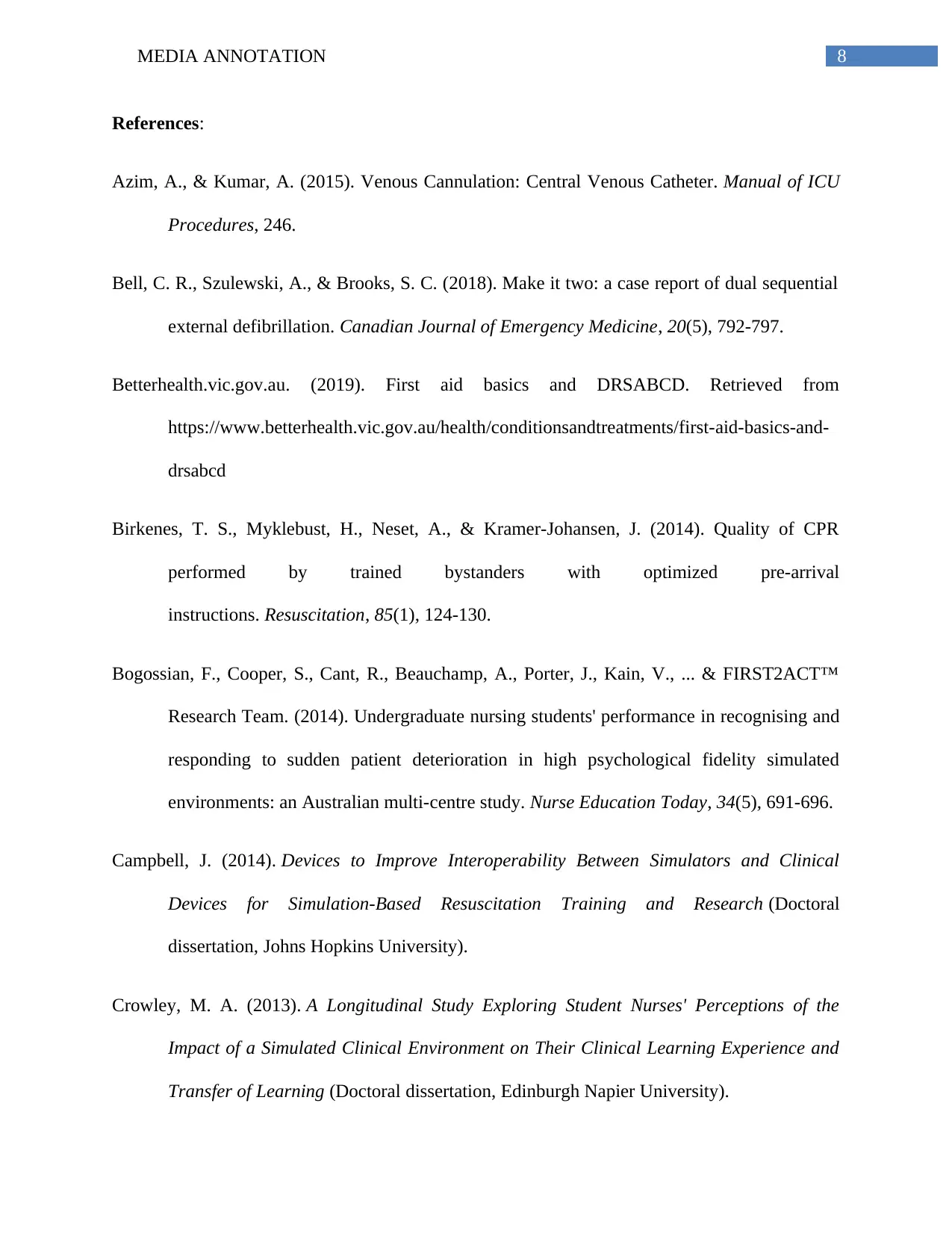
8MEDIA ANNOTATION
References:
Azim, A., & Kumar, A. (2015). Venous Cannulation: Central Venous Catheter. Manual of ICU
Procedures, 246.
Bell, C. R., Szulewski, A., & Brooks, S. C. (2018). Make it two: a case report of dual sequential
external defibrillation. Canadian Journal of Emergency Medicine, 20(5), 792-797.
Betterhealth.vic.gov.au. (2019). First aid basics and DRSABCD. Retrieved from
https://www.betterhealth.vic.gov.au/health/conditionsandtreatments/first-aid-basics-and-
drsabcd
Birkenes, T. S., Myklebust, H., Neset, A., & Kramer-Johansen, J. (2014). Quality of CPR
performed by trained bystanders with optimized pre-arrival
instructions. Resuscitation, 85(1), 124-130.
Bogossian, F., Cooper, S., Cant, R., Beauchamp, A., Porter, J., Kain, V., ... & FIRST2ACT™
Research Team. (2014). Undergraduate nursing students' performance in recognising and
responding to sudden patient deterioration in high psychological fidelity simulated
environments: an Australian multi-centre study. Nurse Education Today, 34(5), 691-696.
Campbell, J. (2014). Devices to Improve Interoperability Between Simulators and Clinical
Devices for Simulation-Based Resuscitation Training and Research (Doctoral
dissertation, Johns Hopkins University).
Crowley, M. A. (2013). A Longitudinal Study Exploring Student Nurses' Perceptions of the
Impact of a Simulated Clinical Environment on Their Clinical Learning Experience and
Transfer of Learning (Doctoral dissertation, Edinburgh Napier University).
References:
Azim, A., & Kumar, A. (2015). Venous Cannulation: Central Venous Catheter. Manual of ICU
Procedures, 246.
Bell, C. R., Szulewski, A., & Brooks, S. C. (2018). Make it two: a case report of dual sequential
external defibrillation. Canadian Journal of Emergency Medicine, 20(5), 792-797.
Betterhealth.vic.gov.au. (2019). First aid basics and DRSABCD. Retrieved from
https://www.betterhealth.vic.gov.au/health/conditionsandtreatments/first-aid-basics-and-
drsabcd
Birkenes, T. S., Myklebust, H., Neset, A., & Kramer-Johansen, J. (2014). Quality of CPR
performed by trained bystanders with optimized pre-arrival
instructions. Resuscitation, 85(1), 124-130.
Bogossian, F., Cooper, S., Cant, R., Beauchamp, A., Porter, J., Kain, V., ... & FIRST2ACT™
Research Team. (2014). Undergraduate nursing students' performance in recognising and
responding to sudden patient deterioration in high psychological fidelity simulated
environments: an Australian multi-centre study. Nurse Education Today, 34(5), 691-696.
Campbell, J. (2014). Devices to Improve Interoperability Between Simulators and Clinical
Devices for Simulation-Based Resuscitation Training and Research (Doctoral
dissertation, Johns Hopkins University).
Crowley, M. A. (2013). A Longitudinal Study Exploring Student Nurses' Perceptions of the
Impact of a Simulated Clinical Environment on Their Clinical Learning Experience and
Transfer of Learning (Doctoral dissertation, Edinburgh Napier University).
⊘ This is a preview!⊘
Do you want full access?
Subscribe today to unlock all pages.

Trusted by 1+ million students worldwide
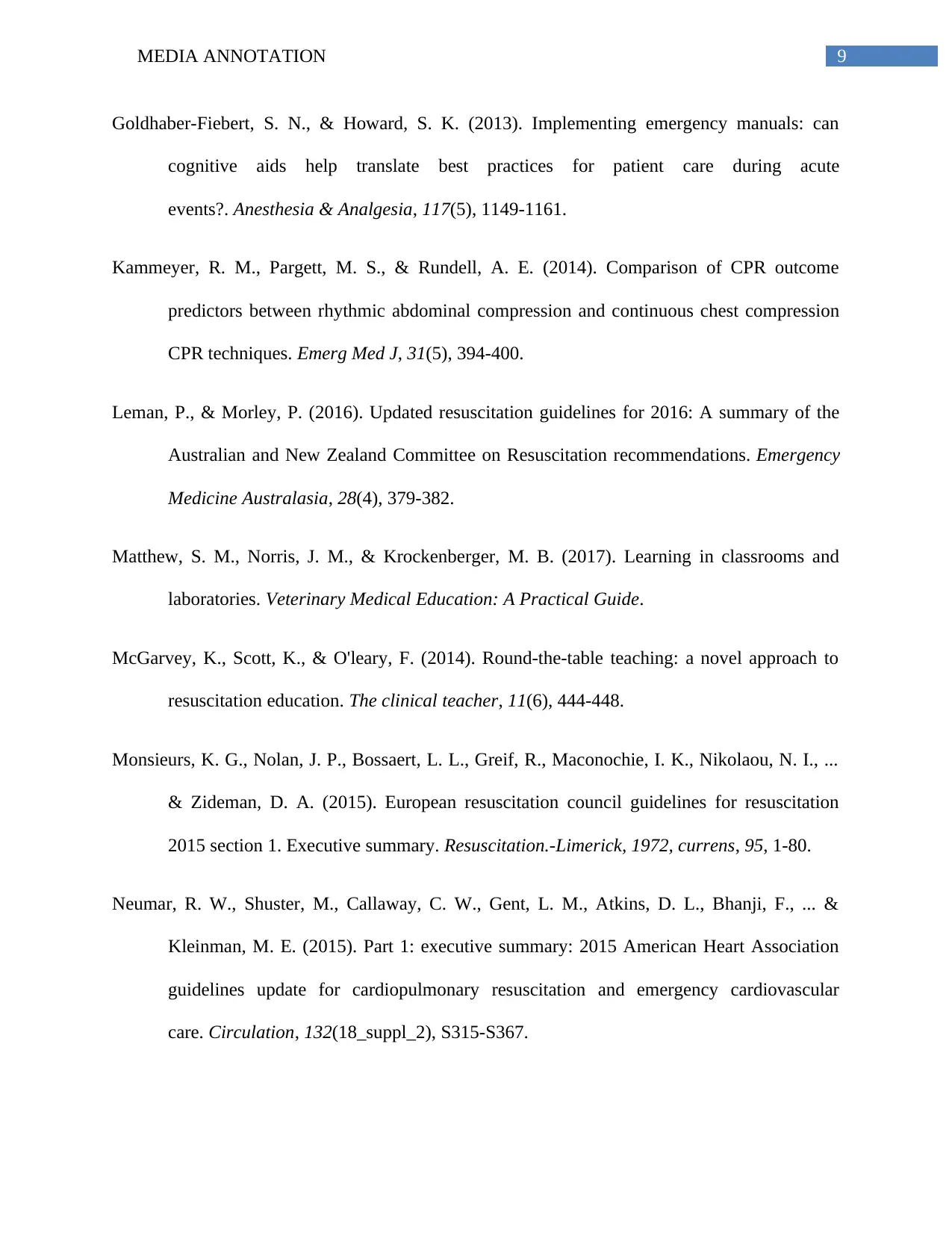
9MEDIA ANNOTATION
Goldhaber-Fiebert, S. N., & Howard, S. K. (2013). Implementing emergency manuals: can
cognitive aids help translate best practices for patient care during acute
events?. Anesthesia & Analgesia, 117(5), 1149-1161.
Kammeyer, R. M., Pargett, M. S., & Rundell, A. E. (2014). Comparison of CPR outcome
predictors between rhythmic abdominal compression and continuous chest compression
CPR techniques. Emerg Med J, 31(5), 394-400.
Leman, P., & Morley, P. (2016). Updated resuscitation guidelines for 2016: A summary of the
Australian and New Zealand Committee on Resuscitation recommendations. Emergency
Medicine Australasia, 28(4), 379-382.
Matthew, S. M., Norris, J. M., & Krockenberger, M. B. (2017). Learning in classrooms and
laboratories. Veterinary Medical Education: A Practical Guide.
McGarvey, K., Scott, K., & O'leary, F. (2014). Round‐the‐table teaching: a novel approach to
resuscitation education. The clinical teacher, 11(6), 444-448.
Monsieurs, K. G., Nolan, J. P., Bossaert, L. L., Greif, R., Maconochie, I. K., Nikolaou, N. I., ...
& Zideman, D. A. (2015). European resuscitation council guidelines for resuscitation
2015 section 1. Executive summary. Resuscitation.-Limerick, 1972, currens, 95, 1-80.
Neumar, R. W., Shuster, M., Callaway, C. W., Gent, L. M., Atkins, D. L., Bhanji, F., ... &
Kleinman, M. E. (2015). Part 1: executive summary: 2015 American Heart Association
guidelines update for cardiopulmonary resuscitation and emergency cardiovascular
care. Circulation, 132(18_suppl_2), S315-S367.
Goldhaber-Fiebert, S. N., & Howard, S. K. (2013). Implementing emergency manuals: can
cognitive aids help translate best practices for patient care during acute
events?. Anesthesia & Analgesia, 117(5), 1149-1161.
Kammeyer, R. M., Pargett, M. S., & Rundell, A. E. (2014). Comparison of CPR outcome
predictors between rhythmic abdominal compression and continuous chest compression
CPR techniques. Emerg Med J, 31(5), 394-400.
Leman, P., & Morley, P. (2016). Updated resuscitation guidelines for 2016: A summary of the
Australian and New Zealand Committee on Resuscitation recommendations. Emergency
Medicine Australasia, 28(4), 379-382.
Matthew, S. M., Norris, J. M., & Krockenberger, M. B. (2017). Learning in classrooms and
laboratories. Veterinary Medical Education: A Practical Guide.
McGarvey, K., Scott, K., & O'leary, F. (2014). Round‐the‐table teaching: a novel approach to
resuscitation education. The clinical teacher, 11(6), 444-448.
Monsieurs, K. G., Nolan, J. P., Bossaert, L. L., Greif, R., Maconochie, I. K., Nikolaou, N. I., ...
& Zideman, D. A. (2015). European resuscitation council guidelines for resuscitation
2015 section 1. Executive summary. Resuscitation.-Limerick, 1972, currens, 95, 1-80.
Neumar, R. W., Shuster, M., Callaway, C. W., Gent, L. M., Atkins, D. L., Bhanji, F., ... &
Kleinman, M. E. (2015). Part 1: executive summary: 2015 American Heart Association
guidelines update for cardiopulmonary resuscitation and emergency cardiovascular
care. Circulation, 132(18_suppl_2), S315-S367.
Paraphrase This Document
Need a fresh take? Get an instant paraphrase of this document with our AI Paraphraser

10MEDIA ANNOTATION
Porter, T. R., Abdelmoneim, S., Belcik, J. T., McCulloch, M. L., Mulvagh, S. L., Olson, J. J., ...
& Wei, K. (2014). Guidelines for the cardiac sonographer in the performance of contrast
echocardiography: a focused update from the American Society of
Echocardiography. Journal of the American Society of Echocardiography, 27(8), 797-
810.
Price, A. M., Smith, S. A., & Challiner, A. (Eds.). (2016). Ward-based critical care: a guide for
health professionals. M&K Update Ltd.
Priori, S. G., Wilde, A. A., Horie, M., Cho, Y., Behr, E. R., Berul, C., ... & Kannankeril, P.
(2013). HRS/EHRA/APHRS expert consensus statement on the diagnosis and
management of patients with inherited primary arrhythmia syndromes: document
endorsed by HRS, EHRA, and APHRS in May 2013 and by ACCF, AHA, PACES, and
AEPC in June 2013. Heart rhythm, 10(12), 1932-1963.
Resus.org.au. (2019). ANZCOR Guideline 8 - Cardiopulmonary Resuscitation - Australian
Resuscitation Council. Retrieved from https://resus.org.au/wpfb-file/anzcor-guideline-8-
cpr-jan16-pdf/
Resus.org.au. (2019). ARC Guideline 11.1 – Introduction to and Principles of In-hospital
Resuscitation - Australian Resuscitation Council. Retrieved from
https://resus.org.au/wpfb-file/arc-guideline-11-1-introduction-to-and-principles-of-in-
hospital-resuscitation_feb-2019-pdf/
Seifert, P. C., Hillberry, C., Astle, S., & Ilkhanoff, L. (2016). Crisis management of cardiac
arrest in the OR. AORN journal, 104(1), 55-66.
Porter, T. R., Abdelmoneim, S., Belcik, J. T., McCulloch, M. L., Mulvagh, S. L., Olson, J. J., ...
& Wei, K. (2014). Guidelines for the cardiac sonographer in the performance of contrast
echocardiography: a focused update from the American Society of
Echocardiography. Journal of the American Society of Echocardiography, 27(8), 797-
810.
Price, A. M., Smith, S. A., & Challiner, A. (Eds.). (2016). Ward-based critical care: a guide for
health professionals. M&K Update Ltd.
Priori, S. G., Wilde, A. A., Horie, M., Cho, Y., Behr, E. R., Berul, C., ... & Kannankeril, P.
(2013). HRS/EHRA/APHRS expert consensus statement on the diagnosis and
management of patients with inherited primary arrhythmia syndromes: document
endorsed by HRS, EHRA, and APHRS in May 2013 and by ACCF, AHA, PACES, and
AEPC in June 2013. Heart rhythm, 10(12), 1932-1963.
Resus.org.au. (2019). ANZCOR Guideline 8 - Cardiopulmonary Resuscitation - Australian
Resuscitation Council. Retrieved from https://resus.org.au/wpfb-file/anzcor-guideline-8-
cpr-jan16-pdf/
Resus.org.au. (2019). ARC Guideline 11.1 – Introduction to and Principles of In-hospital
Resuscitation - Australian Resuscitation Council. Retrieved from
https://resus.org.au/wpfb-file/arc-guideline-11-1-introduction-to-and-principles-of-in-
hospital-resuscitation_feb-2019-pdf/
Seifert, P. C., Hillberry, C., Astle, S., & Ilkhanoff, L. (2016). Crisis management of cardiac
arrest in the OR. AORN journal, 104(1), 55-66.

11MEDIA ANNOTATION
Shin, J., Hwang, S. Y., Lee, H. J., Park, C. J., Kim, Y. J., Son, Y. J., ... & Koh, B. Y. (2014).
Comparison of CPR quality and rescuer fatigue between standard 30: 2 CPR and chest
compression-only CPR: a randomized crossover manikin trial. Scandinavian journal of
trauma, resuscitation and emergency medicine, 22(1), 59.
Shin, J., Hwang, S. Y., Lee, H. J., Park, C. J., Kim, Y. J., Son, Y. J., ... & Koh, B. Y. (2014).
Comparison of CPR quality and rescuer fatigue between standard 30: 2 CPR and chest
compression-only CPR: a randomized crossover manikin trial. Scandinavian journal of
trauma, resuscitation and emergency medicine, 22(1), 59.
⊘ This is a preview!⊘
Do you want full access?
Subscribe today to unlock all pages.

Trusted by 1+ million students worldwide
1 out of 12
Related Documents
Your All-in-One AI-Powered Toolkit for Academic Success.
+13062052269
info@desklib.com
Available 24*7 on WhatsApp / Email
![[object Object]](/_next/static/media/star-bottom.7253800d.svg)
Unlock your academic potential
Copyright © 2020–2025 A2Z Services. All Rights Reserved. Developed and managed by ZUCOL.





